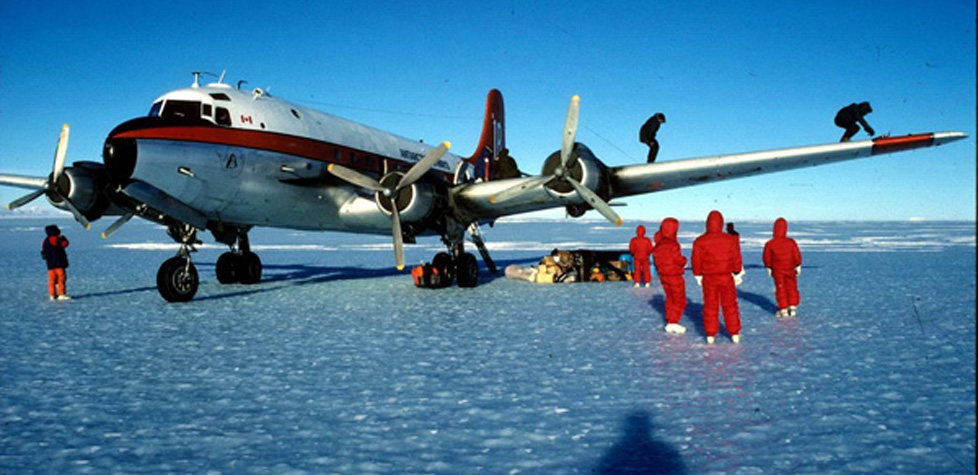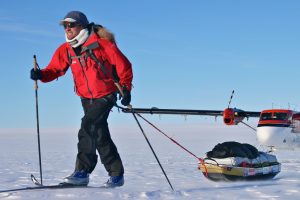The bottom of the world, the globe’s most southern point… since the discovery of the Earth’s axis the South Pole has held a fascination for explorers and adventurers from all corners of the world. How does one get to the South Pole? Is it possible to travel there? Once you do make it, what is actually there?
The Four South Poles
The first question to sort out is what South Pole you’re after. When most people talk about the South Pole they mean the Geographic South Pole, but there are actually four South Poles to consider: geographic, magnetic, geomagnetic, and the Pole of Relative Inaccessibility.
The South Magnetic Pole is where the south-seeking end of your compass needle points to. The magnetic field that attracts your compass needle is created by particles deep in the Earth’s core. The magnetic field is continually moving and scientists monitor these changes and update the World Magnetic Model (WMM) to keep global navigation up to date. As of 2023, the South Magnetic Pole is located just off the coast of Antarctica, in the Southern Ocean south of Australia.
Fun Fact: Research has also shown that the ‘north’ and ‘south’ magnetic poles have swapped places over the years. This is a phenomenon is known as Polar Reversals. Scientists discovered a history of Polar Reversals by studying magma samples around the magnetic poles. Polar Reversals take thousands of years to occur and flip every 300,000 or so years.
The South and North Magnetic Poles aren’t always perfectly opposite of each other. This is where the Geomagnetic Poles comes into play. If you picture a giant bar magnet inside the Earth, the magnet would point to Earth’s North and South Geomagnetic Pole. The Geomagnetic Poles represent the general overall trend of Earth’s magnetic field, especially as it extends to space. While the Geomagnetic Poles don’t have an effect on navigation, they do affect the location of the Northern and Southern lights. As of 2022, the South Geomagnetic Pole was located at 80.65°S 107.32°E.
The Pole of Relative Inaccessibility (POI) is the location on the surface of the Antarctic ice sheet that is furthest from the surrounding coast. Various positions are cited, depending on whether the floating ice shelves that surround Antarctica are included or not. As of 2020, the POI (measured to the outer coast of Antarctica) was located at 83° 54’ S, 64° 53’ E. The POI is an amazing destination in itself but is not the furthest south that most are after.
Which brings us back to the South Geographic Pole, the southern axis of rotation of the Earth. At 90S latitude, it the furthest point south that one can travel to on Earth. Here you will find a marker for the South Geographic Pole, and the ceremonial South Pole. This point was for many years – and still is – the holy grail of polar explorers and adventurers.
History of South Pole Travel
In the late 1700’s and early 1800’s, several expeditions aimed to explore the Southern Ocean and as-yet unknown lands beyond. The Antarctic continent was first sighted in 1820 and multiple expeditions followed, seeking to resolve geographical questions, undertake scientific research, and discover new commercial resources. The expeditions were led by adventurers from around the world and illuminated the unique challenges posed by Antarctic exploration. Interest peaked between the late 1800’s to 1922, during what is now known as the ‘Heroic Age’ of Antarctic exploration.
The first attempt to reach the Geographic South Pole was the 1901-1904 National Antarctic Expedition, led by British explorer Captain Robert Falcon Scott. The expedition traveled to Antarctica aboard the Discovery, a ship custom-built for travel to the polar regions. The team discovered the polar plateau and set a ‘furthest south’ record but turned back on December 30, 1902, after travelling within 410 miles of the Geographic South Pole.
Ernest Shackleton, who had been south with Scott, led another notable attempt between 1907-1909. His team pioneered the Beardmore Glacier route through the Transantarctic Mountains and the use of limited motorized transport. They also set a new ‘furthest south’ record. With winter approaching and running short on supplies, the team turned back just 97 miles from the Geographic South Pole, nearly losing their lives on the return journey. You can view maps of their initial routes into the then unknown Antarctic wilderness here.

In 1910, separate British and Norwegian expeditions sailed south within weeks of one another, initiating a ‘race’ to the South Pole. Roald Amundsen, leader of the Norwegian team, had originally set his sights on the North Pole but secretly changed his objective after that prize was claimed by two other expeditions. The Fram set sail on August 9, 1910, and only after it was underway did Amundsen inform his crew that they would be sailing to Antarctica rather than attempting to drift across the North Pole.
Scott, leader of the earlier Discovery expedition, was already enroute to Antarctica, aboard the Terra Nova, when he received a telegram from Amundsen that simply read: “BEG TO INFORM YOU FRAM PROCEEDING ANTARCTICA – AMUNDSEN”.
Amundsen’s team was the first to arrive at the Geographic South Pole, doing so on December 14, 1911. Historians credit the expedition’s success to Amundsen’s adept use of dogsleds, his focus on the single goal of achieving the Pole, and his quick seven-day passage through the Transantarctic Mountains. His team left a small tent at the South Pole with a Norwegian flag planted atop, and a journal inside, documenting their achievement in case they were unable to return to safety. The five-man team, along with 12 of the original 52 dogs that set out on the expedition, made it safely back to their base camp Framheim on January 26, 1912.
Scott’s team left their base on November 1, 1911 and reached the South Pole on January 17, 1912, four weeks after Roald Amundsen’s Norwegian expedition. Weak and disheartened, the men began their return journey. Along the way, the men took time to collect geological specimens, and carried them to the end, despite their exhaustion and the approaching winter. The rocks contained plant fossils that proved Antarctica was once forested and joined to other continents. A planned meeting with supporting dog teams from the base camp failed, despite Scott’s written instructions. Scott and his companions perished while waiting out a blizzard, 150 miles (241 km) from their base camp and 11 miles (18 km) from the next depot.
Over the same time period, Australian Douglas Mawson led an epic exploration of the Antarctic coastline directly south of Australia (1911-14) and Japanese explorer Nobu Shirase led the first non-European Antarctic expedition.
Shackleton’s attempted crossing of the Antarctic continent (1914-1917) was the last great expedition of the Heroic Age and an epic tale of endurance and survival. By the 1920’s a new era of Antarctic exploration saw the incorporation of vehicles and aircraft and a greater focus on scientific or military objectives.
The International Geophysical Year (IGY) of 1957-58 sparked an intense period of Antarctic exploration and research, with a focus on earth sciences. A number of research stations were established, including Amundsen-Scott South Pole station at the Geographic South Pole; and a Soviet station at the Pole of Inaccessibility. The Commonwealth Trans-Antarctic Expedition (CTAE) led by Sir Vivian Fuchs and Sir Edmund Hillary, successfully completed the first overland crossing of Antarctica, via the South Pole, using tracked vehicles. It was the first expedition to reach the South Pole overland for 46 years. You can view a timeline of Antarctic exploration here.
Commercial South Pole Travel Today

From the 1960s through much of the 1980s, travel to Antarctica was mostly limited to scientific and government research. The enormous distances and costs, along with the complete lack of facilities, were just too daunting for most private expeditions to overcome. In 1985, however, a trio of adventurers organized a successful private expedition to climb Mount Vinson. They formed Adventure Network International (ANI) and, two years later, on November 22, 1987, made history by landing a wheeled DC-4 aircraft, on a naturally occurring blue-ice runway, in the interior of Antarctica. This pioneering achievement paved the way for non-governmental expeditions to notable Antarctic landmarks such as Mount Vinson (Antarctica’s highest peak) and the Geographic South Pole. You can learn more about this historic flight here.
In 2003, ANI was purchased by Antarctic Logistics & Expeditions (ALE). ALE has continued to uphold ANI’s legacy of Antarctic exploration and has carried thousands of passengers to the region and supported almost every expedition that has skied to the South Pole, or crossed the continent.
Today ALE offers different options for the modern-day explorer to travel to the South Pole, with trips ranging from adventurous vacations to grueling expeditions. How you experience the South Pole is entirely up to you.
Flying to the South Pole
Adventurers can fly to the South Pole on one of our ski aircraft. The trip starts with an intercontinental flight to our base camp at Union Glacier. From there, guests have the option of a day trip or an overnight stay at the South Pole.
The day trip is an excellent option for those who wish to experience the adventure of the South Pole and return to the comforts of Union Glacier at the end of the day. Our location at 79 45S offers the shortest flight time to the South Pole (4-5 ½ hrs) and makes a true day trip possible, with no intermediate camp on the return journey. Guests have about 2-3 hours at the pole for photos and to take in the historical location before returning to Union Glacier for a hot meal and a good night’s sleep.
For those who want to stay overnight, ALE has a one-of-a-kind South Pole Field Camp, complete with Arctic Oven Tents to sleep in, a main dining tent with chef, and toilet facilities. Our heated, double walled sleeping tents are designed to withstand the especially harsh Antarctic conditions and are equipped with the same types of cots, mattresses, and pillows used at Union Glacier. Each is named after a famous Antarctic explorer.
ALE’s South Pole camp sits only 0.6 miles (1km) from the Geographic South Pole marker, the Ceremonial Pole and the Amundsen-Scott South Pole station. Our South Pole overnight experience is a truly unique adventure, perfect for guests who want extra time to drink in the one-of-a-kind environment.
Skiing to the South Pole

Russ Hepburn
For those wanting to connect with the Antarctic explorers who came before them, ALE offers ski expeditions to the South Pole ranging from two weeks to the full Antarctic season. These are best suited for extreme expeditionists, who are comfortable in the elements, and willing to commit to an intense, pre-trip training program. ALE requires guests to have prior ski and winter outdoor experience before being cleared to participate.
The shortest option to ski to the South Pole is ALE’s Ski the Last Degree experience. Adventurers are dropped off at the 89°S line of latitude longitudinal and ski the last 60 nautical miles (69 mi/111km) to the Geographic South Pole. Guests drag their gear behind them on a pulk (sled) and camp out on the high polar plateau. Despite its shorter, two-week time frame, the Ski Last Degree experience is an extremely challenging expedition, with long days of intense activity at altitude and in extreme cold.
Our longer expeditions offer the ultimate mental and physical challenge. There are several different route options to consider:
- Hercules Inlet
- Start at Hercules Inlet, where the edge of the Antarctic continent meets the Ronne Ice Shelf. This route takes between 50 – 60 days to complete, climbing from sea level to more than 9300 ft (2835 m).
- Messner Start
- Inspired by Reinhold Messner’s 1989 Antarctic crossing, this route offers a shorter but more demanding expedition. The Messner Start route takes up to 50 days and climbs gradually to more than 9300 ft (2835 m).
- Axel Heiberg
- This committing expedition starts on the far side of the continent and travels the route pioneered by Amundsen and his team in 1911. It ascends the steep Axel Heiberg Glacier, then navigates around the infamous maze of crevasses known as the Devil’s Ballroom, and across the polar plateau. This route takes between 40-50 days and reaches elevations up to 9500 ft (2900 m).
- The Path Less Traveled
- While most expeditions follow the routes listed above there are other less-traveled routes available to explorers. These include starting from the northern edge of Berkner Island or from Constellation Inlet.
Visiting the South Pole FAQs
Below are some frequently asked South Pole Travel questions with answers from ALE’s Travel Specialists, who have years of experience helping people travel to Antarctica.
- How do I get to the South Pole?
- Depending on what type of adventure you’re looking for, ALE offers flight and ski options to travel to the South Pole.
- What will I see at the South Pole?
- When Amundsen and Scott arrived at the South Pole, it was an empty expanse of ice, stretching northwards in all directions. These days, the South Pole is a crossroads for science, history and adventure. The area around the Pole is an Antarctic Specially Managed Area. It is home to Amundsen-Scott South Pole Station, a large US base comprised of a central, elevated station, outlying science labs and facilities, and a skiway. The Geographic South Pole is located close to the station, with a decorative survey marker and a sign commemorating the achievements of Amundsen and Scott. Not far away lies the Ceremonial Pole, a striped pole with a reflective ball on top, surrounded by the flags of the original signatories to the Antarctic Treaty. Like much of Antarctica, the South Pole is covered by glacial ice, many thousands of feet thick. The ice is gradually flowing toward the coast and moves at a rate of approximately 33 feet (10m) per year. Because of this, over the course of the year, the pole marker gradually moves away from the Geographic South Pole. Each January 1, a new marker designed and fabricated by the overwintering station staff is placed at 90S.
- Is there tour of the South Pole Station?
- You’ll be able to see the outside of the station, but currently there are no tours being offered inside the base.
- Where can I go once I’m at the South Pole?
- Visitors to the South Pole are expected to stay in the vicinity of the Geographic and Ceremonial South Pole markers, or at ALE’s South Pole Camp. All other areas are off-limits to visitors.
- If I spend the night, what are the tents like?
- Our tented camp at the South Pole is designed to provide as much comfort and security as possible given the extreme environment. You will be sleeping in Arctic Oven tents. These double-walled, heated tents are designed to withstand Antarctic conditions. We provide cots, padded sleeping mats and pillows to use with your polar-rated sleeping bag.
- Are there bathrooms at the South Pole?
- Our South Pole Camp toilets are surprisingly comfortable and private. Housed in a tent and similar to those at Union Glacier Camp, we clean them regularly and provide hand sanitizer in each. There are no showers at our South Pole Camp.
- How far away is ALE’s South Pole camp from the Geographic South Pole?
- A short .6 mi (1 km) walk.
- How long is the flight there?
- Depending on the aircraft, flights to the South Pole from our Union Glacier base take between 4-5.5 hours.
- What do I wear to the South Pole?
- You can view a full guide to the required clothing and equipment list for our fly-in trips here. Essentials include appropriate insulated jacket and pants, gloves, goggles and head gear. ALE has rental options available for guests.
- Sled hauling on Ski Last Degree and Ski South Pole experiences requires different clothing and equipment. What equipment you’ll need will depend on what route you are taking.
- What is the weather like at the South Pole?
- Be prepared for extreme cold and the effects of altitude during your stay. South Pole temperatures range from -31° to -13°F (-35° to -25°C) and even the slightest breeze can quickly freeze exposed skin.
- How high is the South Pole?
- The elevation at the South Pole is approximately 9300 ft (2835m) but it generally feels closer to 10,500 ft (3,200m), due to the compressed atmosphere at the poles.
- What if I get sick at the South Pole?
- One of our experienced medics accompanies all South Pole flights and is ready to assist you should you have any issues with the cold or altitude.
Interested in experiencing the Geographic South Pole yourself? Contact one of our travel specialists today – we’d love to make your Antarctic travel dreams a reality.





